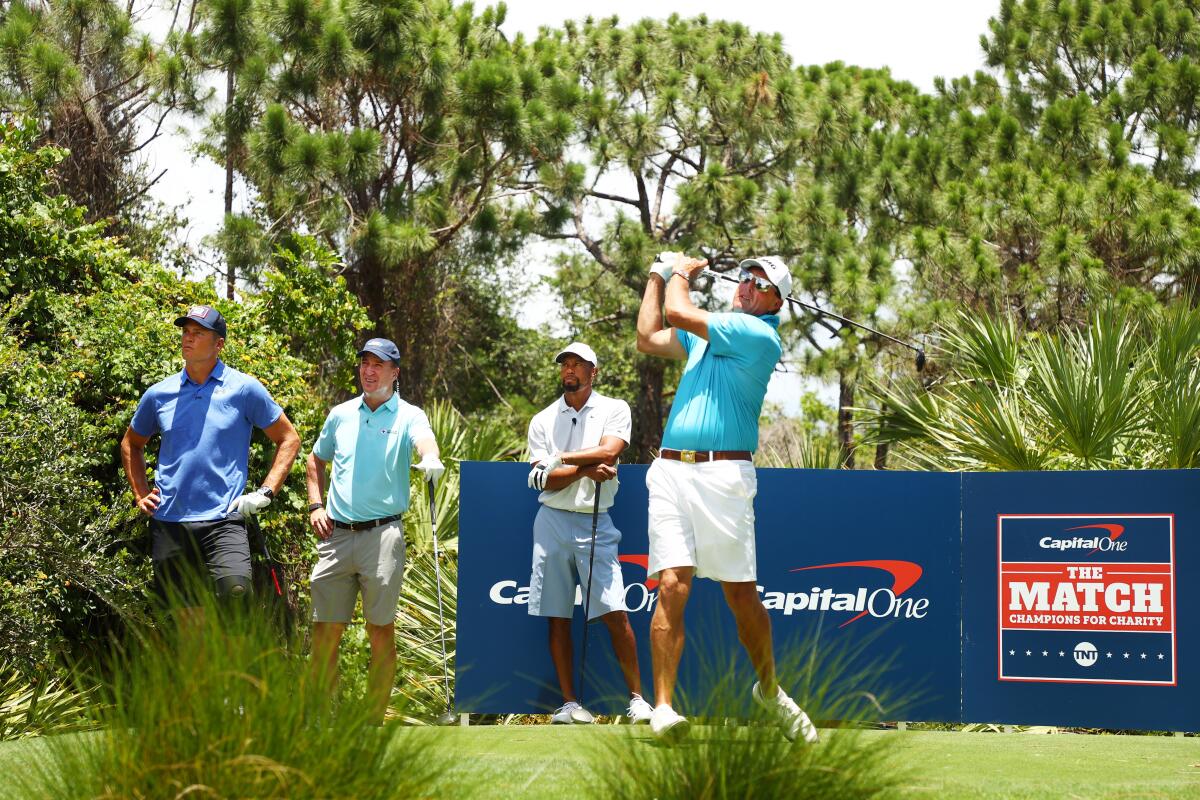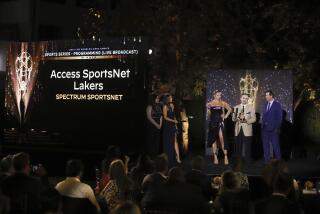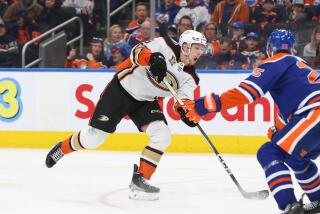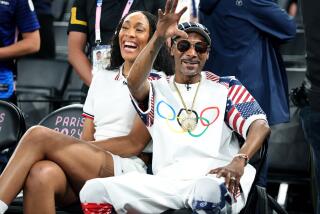Live sports is coming back to TV. But you’ll have to choose between games
After seeing the coronavirus pandemic cancel major sporting events such as the NCAA Men’s Basketball Championship and the Summer Olympics, fans may soon be faced with too much of a good thing.
The planned return of the National Hockey League and the National Basketball Assn., along with rescheduled PGA golf tournaments, Triple Crown horse racing, a new NFL season and the possibility of an abbreviated Major League Baseball campaign with extended playoffs, could be a bounty for the sports-starved viewer — and financial salvation for the TV networks that carry them and have billions of dollars tied up in broadcast rights fees.
“There is a tremendous pent up desire to see sports,” said Jeff Zucker, chairman of WarnerMedia News and Sports. “And there is certainly a lot of pent up demand among networks and advertisers.”
A possible downside of the leagues making an effort to return their games outside of their usual season calendars is a logjam of events in the fall. That could fragment the TV sports audience and spread advertising dollars too thin. But many of those events may end up filling the prime time schedules of TV networks, which are still uncertain when production on scripted programming for the 2020-21 fall TV season will begin.
Sports TV producers will also be faced with creating an enjoyable viewing experience even though the excitement created by fans in the stands will be missing. The return of live spectators in stadiums and arenas is still months off, turning most sports venues into giant TV production studios.
But sports media executives who spoke with The Times said they have reasons to be encouraged. The high viewing levels for the few live sports events of the last two months — including “The Match II,” a celebrity golf round that aired May 24 on TNT and other WarnerMedia networks and a Fox Sports airing of a NASCAR cup series race — demonstrate that audiences are ravenous for a return of a full slate of games.
“Wherever anybody is putting sports content on, it’s resonating with the audience,” said Jimmy Pitaro, president of ESPN. “It’s a real positive sign.”
ESPN saw its ad revenues drop 8% year-to-year in the first quarter, according to Disney’s recent earnings, largely due to the loss of live events, and will be hit even harder by cancellations through June. But the network’s executives also sense the hunger of fans for the return of sports through their response to “The Last Dance.”
The Walt Disney Co. unit’s documentary series on NBA superstar Michael Jordan was rushed onto the air in April once the network’s slate of live events disappeared amid the pandemic concerns. According to Nielsen data, 47 million people watched some portion of the 10-episode series, which was presented over five weeks and analyzed by sports journalists, talk show hosts and social media users as if it were a live event rather than an account of championship games played more than 20 years ago.

Even after viewers knew that live sports were not returning anytime soon, they still gravitated to ESPN, as its ratings in April were 11% higher than the last two weeks of March, thanks largely to a record-setting audience for the NFL Draft and “The Last Dance.” Many hours have been filled with telecasts of classic games, but live studio shows have continued, giving fans a daily helping of hope on when action will return.
The need for networks to fill hours of programming is likely to result in upgraded time periods for sports events. On Saturday, NBC is airing the Genesys 300 in Fort Worth, TX, a rare occurrence of an Indy Car racing event presented in prime time on a broadcast network.
“That’s a prelude to what’s going to be happening this fall,” said Lee Berke, chief executive of LHB Sports, Media and Entertainment. “There will be a flight to quality. You’ve got to think that reruns of scripted programs will have a difficult time getting an audience.”
If ESPN cannot accommodate all of its events on its cable channels, it’s likely some will turn up in prime-time slots on Disney-owned broadcast network ABC. Its streaming service ESPN+ could also provide coverage.
Overall, the return of sports is expected to be a shot in the arm for the TV advertising marketplace, which has been rocked by the economic shutdowns in place across the country to control the pandemic. National TV advertising showed a year-over-year decline of 27% to $2.7 billion in April with the cancellation of sports, according to data from Standard Media Index.
Live sports are the most valuable programming assets for networks in their effort to combat the loss of viewers to streaming video services.
One network sales executive not authorized to speak publicly on the matter said networks are optimistic about selling commercial time when sports return. The postponement of the Olympics on NBC has many of its sponsors looking for events with big audiences this summer. Many advertisers who purchased time in ESPN’s coverage of the NBA Finals before the season was suspended have kept their ad commitments in the games if they are played later in the year.
Last year, the six games of NBA Finals alone pulled in $280 million in advertising revenue, according to Kantar Media. ESPN and Turner Sports pay $2.6 billion a year for the TV rights to the entire NBA season.
While some major advertiser categories such as restaurants and travel services are expected to be slow to come back, having athletes back in action should signal a return to normalcy, which many companies will likely want to celebrate, the executive said.
Even with the confidence that audiences and ad dollars will come back, executives acknowledge there is still work to be done on the production side so that they can deliver the kind of sports viewing experience TV audiences are used to.
The NBA, which has set a target return date of July 31, will in all likelihood play its remaining games at the 220-acre ESPN Wide World of Sports complex located at Walt Disney World in Orlando, removing the texture provided by loyal local followers of the teams. The NHL will hold its Stanley Cup Playoffs in two yet-to-be designated cities.
The limitations of the venues have networks talking to leagues about what kind of enhancements they can make to sports broadcasts. There are discussions about using recorded crowd noise, but even that bit of artifice becomes tricky.
“When announcers are calling a great play whether it’s a touchdown or a sack or a big interception, part of the reason they get excited as they do is because the crowd is in there going crazy,” said one TV sports executive who spoke on the condition of anonymity.
Executives say it would be better if the leagues control any recorded sounds in the stadiums and arenas so that networks don’t have to make an editorial judgement.
But the lack of fans is also chance for networks to try innovations in their coverage. ESPN’s Pitaro has long advocated a more close-up-and-personal approach in covering athletes, which he believes is necessary to attract younger viewers.
While courtside cameras would interfere with fans’ views in an NBA game, ESPN could experiment with new angles and enhanced audio.
ESPN already learned through its coverage of the NFL Draft — where coaches and league executives were seen at home surrounded by family members, souvenirs and favorite alcoholic beverages — that fans enjoy any added intimacy.
“There was a reason ‘MTV Cribs’ worked so well,” Pitaro said. “People love to see an athlete or an entertainer let their guard down in their own environment, giving the fan more access to the players unguarded.”
Zucker said “The Match II” enabled Turner to use live microphones on the golf course and cameras in the players’ carts, enabling viewers to see their responses to the action in real time. He also believes the restrictions on fans will be an opportunity to innovate.
“We’re going to be much more open to experimentation, and that’s a good thing,” Zucker said.
At the same time, TV networks have to consider the health and safety of the technicians, producers and on-air talent who travel to events and are used to working closely side-by-side.
Berke said fans should expect announcing teams to call more games from remote locations, something ESPN already does with some of its collegiate sports coverage, and NBC with its Olympics telecasts.
If Major League Baseball returns, at least one team will have its announcing teams stay home during road games, and give their play-by-play calls and analysis from studios while watching video monitors, according to an agent familiar with the plan.
There may also be a long-term effect of sports networks adapting to the use of a smaller workforce to cover events.
“We had fewer people, fewer cameras and fewer people in the control production truck at ‘The Match,’” Zucker said. “You learn how to do more with less.”
More to Read
Inside the business of entertainment
The Wide Shot brings you news, analysis and insights on everything from streaming wars to production — and what it all means for the future.
You may occasionally receive promotional content from the Los Angeles Times.











